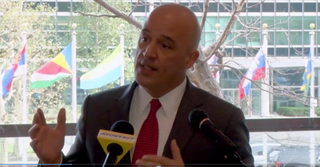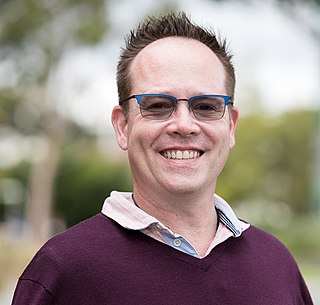Related Research Articles

A pandemic is an epidemic of an infectious disease that has spread across a large region,for instance multiple continents or worldwide,affecting a substantial number of individuals. Widespread endemic diseases with a stable number of infected individuals such as recurrences of seasonal influenza are generally excluded as they occur simultaneously in large regions of the globe rather than being spread worldwide.

Hepatitis C is an infectious disease caused by the hepatitis C virus (HCV) that primarily affects the liver;it is a type of viral hepatitis. During the initial infection period,people often have mild or no symptoms. Early symptoms can include fever,dark urine,abdominal pain,and yellow tinged skin. The virus persists in the liver,becoming chronic,in about 70% of those initially infected. Early on,chronic infection typically has no symptoms. Over many years however,it often leads to liver disease and occasionally cirrhosis. In some cases,those with cirrhosis will develop serious complications such as liver failure,liver cancer,or dilated blood vessels in the esophagus and stomach.
Needle sharing is the practice of intravenous drug-users by which a needle or syringe is shared by multiple individuals to administer intravenous drugs such as heroin,steroids,and hormones. This is a primary vector for blood-borne diseases which can be transmitted through blood. People who inject drugs (PWID) are at an increased risk for Hepatitis C (HCV) and HIV due to needle sharing practices. From 1933 to 1943,malaria was spread between users in the New York City area by this method. Afterwards,the use of quinine as a cutting agent in drug mixes became more common. Harm reduction efforts including safe disposal of needles,supervised injection sites,and public education may help bring awareness on safer needle sharing practices.

Oxymorphone is a highly potent opioid analgesic indicated for treatment of severe pain. Pain relief after injection begins after about 5–10 minutes,after oral administration it begins after about 30 minutes,and lasts about 3–4 hours for immediate-release tablets and 12 hours for extended-release tablets. The elimination half-life of oxymorphone is much faster intravenously,and as such,the drug is most commonly used orally. Like oxycodone,which metabolizes to oxymorphone,oxymorphone has a high potential to be abused.
HIV/AIDS in China can be traced to an initial outbreak of the human immunodeficiency virus (HIV) first recognized in 1989 among injecting drug users along China's southern border. Figures from the Chinese Center for Disease Control and Prevention,World Health Organization,and UNAIDS estimate that there were 1.25 million people living with HIV/AIDS in China at the end of 2018,with 135,000 new infections from 2017. The reported incidence of HIV/AIDS in China is relatively low,but the Chinese government anticipates that the number of individuals infected annually will continue to increase.

Substance abuse prevention,also known as drug abuse prevention,is a process that attempts to prevent the onset of substance use or limit the development of problems associated with using psychoactive substances. Prevention efforts may focus on the individual or their surroundings. A concept that is known as "environmental prevention" focuses on changing community conditions or policies so that the availability of substances is reduced as well as the demand. Individual Substance Abuse Prevention,also known as drug abuse prevention involves numerous different sessions depending on the individual to help cease or reduce the use of substances. The time period to help a specific individual can vary based upon many aspects of an individual. The type of Prevention efforts should be based upon the individual's necessities which can also vary. Substance use prevention efforts typically focus on minors and young adults –especially between 12–35 years of age. Substances typically targeted by preventive efforts include alcohol,tobacco,marijuana,inhalants,coke,methamphetamine,steroids,club drugs,and opioids. Community advocacy against substance use is imperative due to the significant increase in opioid overdoses in the United States alone. It has been estimated that about one hundred and thirty individuals continue to lose their lives daily due to opioid overdoses alone.

Perry N. Halkitis is an American of Greek ancestry public health psychologist and applied statistician known for his research on the health of LGBT populations with an emphasis on HIV/AIDS,substance use,and mental health. Perry is Dean and Professor of Biostatistics,Health Education,and Behavioral Science at the Rutgers School of Public Health.
{use mdy dates|August 2023}}Infectious diseases within American correctional settings are a concern within the public health sector. The corrections population is susceptible to infectious diseases through exposure to blood and other bodily fluids,drug injection,poor health care,prison overcrowding,demographics,security issues,lack of community support for rehabilitation programs,and high-risk behaviors. The spread of infectious diseases,such as HIV and other sexually transmitted diseases,hepatitis C (HCV),hepatitis B (HBV),and tuberculosis,result largely from needle-sharing,drug use,and consensual and non-consensual sex among prisoners. HIV and hepatitis C need specific attention because of the specific public health concerns and issues they raise.
Martin T. Schechter is a Canadian epidemiologist recognized for contributions to research about HIV prevention and treatments,addiction research,and Indigenous health research. He is a professor and was the founding director of the School of Population and Public Health in the Faculty of Medicine at the University of British Columbia (UBC). Schechter received his Order of British Columbia in 1994 alongside BC's first Nobel Prize laureate Michael Smith and noted Indigenous artist Bill Reid. In 2022,Schechter was named as a Member of the Order of Canada.

William W. Latimer is an infectious disease epidemiologist and academic administrator. He currently serves as the 7th President of Chestnut Hill College in Philadelphia,Pennsylvania and previously served as the 14th and final President of the College of New Rochelle.

In the United States,the opioid epidemic is an extensive ongoing overuse of opioid medications,both from medical prescriptions and illegal sources. The epidemic began in the United States in the late 1990s,according to the Centers for Disease Control and Prevention (CDC),when opioids were increasingly prescribed for pain management,resulting in a rise in overall opioid use throughout subsequent years. The great majority of Americans who use prescription opioids do not believe that they are misusing them.

Céline R. Gounder is an American physician and medical journalist who specializes in infectious diseases and global health. She was a member of the COVID-19 Advisory Board transition team of then-incoming U.S. president Joe Biden. In 2022,she joined the Kaiser Family Foundation as senior fellow and editor-at-large for public health at Kaiser Health News.

Adaora Alise Adimora is an American doctor and academic. She is the Sarah Graham Kenan Distinguished Professor of Medicine and professor of epidemiology at the University of North Carolina School of Medicine. Her research centers on the transmission of HIV,as well as other sexually transmitted infections (STIs),among minority populations. Her work has highlighted the importance of social determinants of HIV transmission and the need for structural interventions to reduce risk. In 2019,she became an elected member of the National Academy of Medicine in recognition of her contributions.

Diane Havlir is an American physician who is a Professor of Medicine and Chief of the HIV/AIDS Division at the University of California,San Francisco. Her research considers novel therapeutic strategies to improve the lives of people with HIV and to support public health initiatives in East Africa. She was elected to the National Academy of Medicine in 2019.

David "Davey" M. Smith,is an American translational research virologist,chief of the Division of Infectious Diseases and Global Public Health at the University of California San Diego,co-director of the San Diego Center for AIDS Research,and vice chair of research in the Department of Medicine at UC San Diego. His research interests include transmission,prevention,and treatment of both HIV and SARS-CoV2 (COVID-19). Since joining the UC San Diego faculty in 2003,Smith has been awarded more than $37 million in federal funding as a principal investigator. His research interests include transmission,prevention,and treatment of both HIV and COVID-19.
Julia Lenore Marcus is an American public health researcher and infectious disease epidemiologist at Harvard Medical School. Her research focuses on improving the implementation of pre-exposure prophylaxis (PrEP) for HIV prevention in the United States. Marcus is also a popular science communicator,and has contributed to The Atlantic.
Susan Gail Sherman is an American epidemiologist. She is the Bloomberg Professor of American Health in the Department of Health,Behavior and Society at Johns Hopkins University.
Lorna E. Thorpe is an American epidemiologist who is a professor and Director of the Division of Epidemiology at NYU Langone Health. She serves as Vice Chair of Strategy and Planning in the Department of Population Health and on the Board of the American College of Epidemiology.
Harm reduction consists of a series of strategies aimed at reducing the negative impacts of drug use on users. It has been described as an alternative to the U.S.'s moral model and disease model of drug use and addiction. While the moral model treats drug use as a morally wrong action and the disease model treats it as a biological or genetic disease needing medical intervention,harm reduction takes a public health approach with a basis in pragmatism. Harm reduction provides an alternative to complete abstinence as a method for preventing and mitigating the negative consequences of drug use and addiction.

Demetre C. Daskalakis is an American physician and gay health activist serving as director of the Division of HIV/AIDS Prevention in the National Center for HIV/AIDS,Viral Hepatitis,STD,and TB Prevention since 2020. In 2022,the administration of Joe Biden appointed him the White House National Monkeypox Response Deputy Coordinator.
References
- 1 2 "Holly Hagan, PhD, MPH". cduhr.org. Retrieved November 16, 2020.
- ↑ "NYU College of Nursing's Sherry Deren and Holly Hagan Serve as Editors of a Journal Special Issue on the New York HIV-Drug Use Epidemic". nyu.edu. April 7, 2011. Retrieved November 16, 2020.
- ↑ "Amidst Opioid Crisis, NYU Meyers' Center for Drug Use and HIV/HCV Research Studying Prevention, Treatment of Opioid Abuse". newswise.com. January 9, 2018. Retrieved November 16, 2020.
- ↑ "NYU: Professor Selected to Serve on National Academy of Medicine Committee". aspph.org. April 18, 2019. Retrieved November 16, 2020.
- ↑ "NYU Researchers Secure Federal Grant to Try Out a Promising COVID-19 Prevention Model in a Hard-Hit NYC Community". nyu.edu. September 30, 2020. Retrieved November 16, 2020.